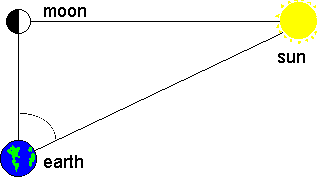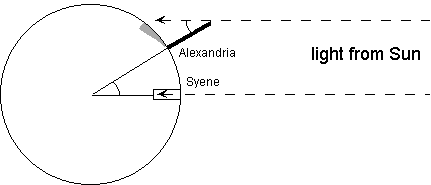

Long before the number of days in a year was known and the calendar was invented, people recognized that the stars rise and set at the same point on the horizon each night, but not the Sun--the rising and setting point of the Sun depend on the season.
Various monuments such as Stonehenge (in Britain) and medicine wheels in North America are aligned with features such as the northernmost and southernmost rising or setting points of the Sun. These sites are thus astronomical observatories that may have been used to determine planting seasons. The approach of planting time can thus be predicted without having a calendar, without knowing the number of days in a year, without even knowing how to count.
A year is one complete cycle of the seasons, i.e. a complete cycle of apparent movement by the Sun. Thus our calendar year is based on the movement of the Sun, and is called a solar calendar. The year based on the seasons is called a tropical year.
EGYPT
2800 B.C. Some pyramids are aligned with significant orientations of the bright stars. Imhotep, the architect of the first pyramid, enters mythology as the first astronomer.
Calendars
The task is to reconcile these calendars.
(12 x 29 1/2
![]() 365 1/4)
Until late in their history, the ancient Egyptians did this
empirically,
that is, by observation, without the aid of mathematics.
365 1/4)
Until late in their history, the ancient Egyptians did this
empirically,
that is, by observation, without the aid of mathematics.
MESOPOTAMIA (Assyria and Babylonia)
ca. 700 B.C., Mesopotamian astronomers start recording data to synchronize calendars (perhaps partly also for astrological purposes)
ca. 480 BC, develop a systematized cycle (Metonic): 19 years=235 months to great accuracy. This discovery was possible because of the long period over which observations had been made.
Other Babylonian achievements
New features of Babylonian astronomy: it was both mathematical and predictive. As they had no calculus, algebra or trigonometry, and very little geometry, the calculating techniques of the Babylonians were strictly based on arithmetic--very complicated motions had to be described with very simple mathematics!
THE GREEKS
Archaic period
Early philosophers (e.g. Pythagoras, Thales, 6th C BC) began to speculate about causes and origins of natural phenomena, reasoning from observation
Classical period
A period of remarkable achievements in all branches of the arts and sciences occurred in Greece beginning roughly in 479 BC with the victory over the Persian Empire at Thermopylae.
PLATO (427? - 347 BC) describes the stars as being attached to a celestial sphere centered on the Earth. He also describes the ecliptic and the celestial equator.
EUDOXUS (408 - 355 BC) introduces a 4-sphere model to account qualitatively for more complicated motions of the planets. Model fails to account for brightness variations
ARISTOTLE (384 - 322 BC) describes and enlarges the model of Eudoxus to 55 spheres. The Earth is stationary at the center, and the Sun, Moon and planets go around the Earth (geocentric model).
Among his many good ideas:
Aristotle's system was very complete and persuasive, though not universally accepted even in antiquity
HERACLEIDES (388? - 315 BC) proposes that the Earth rotates, not the celestial sphere. He may also have suggested that Mercury and Venus orbit the Sun, not the Earth.
ARISTARCHUS (320? - 250? BC) proposes, nearly 2000 years before Copernicus, that all the planets orbit the Sun, including the Earth (heliocentric model)
The heliocentric model greatly simplifies the description of the motions of the planets, but there was no direct evidence for it.
One objection to the heliocentric model is that we don't observe parallax of the stars. Aristarchus recognized the objection and correctly argued that this must mean that the stars are very far away.
Another remarkable achievement of Aristarchus was his attempt to measure the relative distance and sizes of sun and moon. His results were poor, because he used erroneous measurements as input data, but his methods were correct.

Hellenistic period.
By the time Alexander the Great died in 322 BC, he had conquered many of the great civilizations of the world, including Egypt, Persia and even part of India. Although his empire fell apart after his death, his generals established kingdoms where Greek culture blended with the native cultures. Greek became the international language, and the language of learning.
ERATOSTHENES (276? - 196? BC):
measures radius of earth with about 20% error.

HIPPARCHUS (190?- 120 BC):
APOLLONIUS OF PERGA (261? - 190? BC): introduces epicycles and eccentric circles
PTOLEMY (b. ca. 75 AD): Megiste Mathematike Syntaxis (handed down in Arabic as the Almagest).
The Ptolemaic system was a great astronomical achievement unequalled until the Renaissance.
Further reading about ancient astronomy.
your instructor